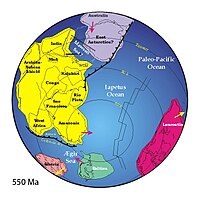
Photo from wikipedia
The key to defining the termination of accretion in an accretionary orogen is to recognize the initial magmatic processes that are generated at the time of ocean closure. We present… Click to show full abstract
The key to defining the termination of accretion in an accretionary orogen is to recognize the initial magmatic processes that are generated at the time of ocean closure. We present new age, geochemical, and isotopic data for magmatic rocks related to terminal collision along the Solonker-Xar Moron suture zone in the southern Central Asian Orogenic Belt (CAOB) that record such processes following closure of the Paleo-Asian Ocean. These magmatic rocks were emplaced in the Early-Middle Triassic (251–245 Ma) and show high Sr/Y signatures. Their low MgO, Cr, and Ni contents and variable whole-rock eNd(t) values (+5.8 to −5.3), together with the range in zircon eHf(t) (+15.6 to −9.8) and δ18O values (5.1 to 7.9‰), indicate an origin from partial melting of juvenile lower crustal rocks with some old components, including supracrustal recycling under garnet amphibolite facies conditions. Our data, along with available geological and geophysical evidence, lead us to propose a model of final oceanic contraction in the southern CAOB, resulting in sublinear distribution of high Sr/Y melts along the resultant collision zone, thus defining the onset of postaccretionary processes in the southern CAOB. The identification of collision-related high Sr/Y granitoids from the southern CAOB not only reveals the magmatic process in response to the final episode of orogenic evolution in the CAOB accretionary collision zone but also constrains how and when an archipelago-type accretionary orogen is terminated.
Journal Title: Journal of Geophysical Research
Year Published: 2017
Link to full text (if available)
Share on Social Media: Sign Up to like & get
recommendations!